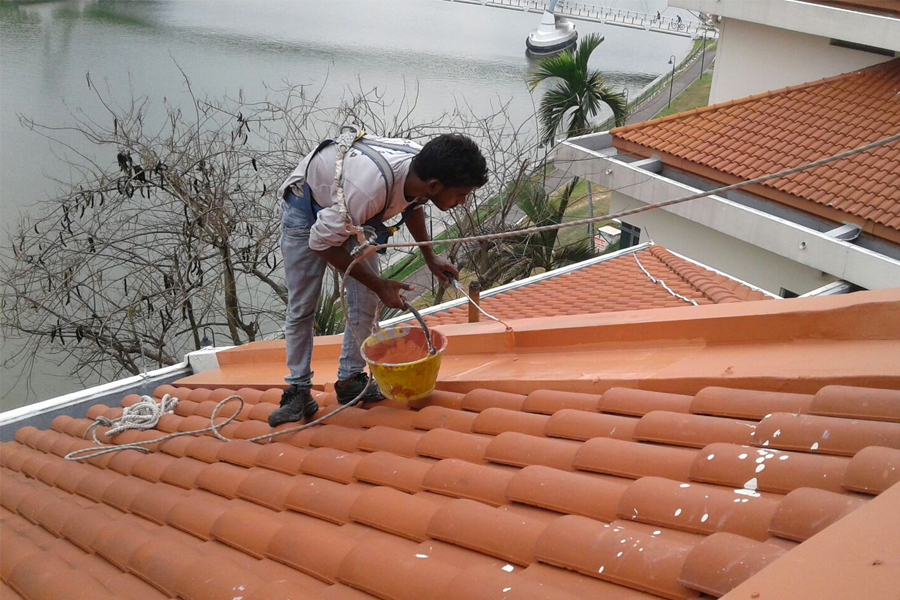Pitched roofs are a popular choice for homeowners due to their aesthetic appeal and the efficient way they shed water. However, regardless of the roof’s quality and materials, over time, waterproofing can become compromised due to wear and tear, weather conditions, or poor installation. To keep your pitched roof watertight and protected from potential leaks, it is crucial to understand and implement specialized waterproofing techniques. In this article, we will explore various methods to ensure your pitched roof remains durable and leak-free.

Importance of Waterproofing Pitched Roofs
A pitched roof is designed to shed water effectively, but even the slightest imperfections in your roofing system can cause leaks or water damage. Here are some key reasons why waterproofing your pitched roof is essential:
-
Preventing structural damage: Water leaks can lead to structural damage, compromising the overall integrity of your roof and potentially affecting the entire building structure.
-
Protecting the interior: Leaks can harm the interior of a building, causing damage to walls, ceilings, insulation, and even valuable belongings.
-
Preventing health issues: Moisture buildup can create a breeding ground for mold and mildew, which can trigger health problems such as respiratory issues and allergies.
-
Preserving energy efficiency: A compromised roof can result in heat loss or gain, increasing your energy consumption and utility costs.
To ensure the long-term protection and performance of your roofing system, it is essential to implement specialized waterproofing techniques.
Waterproofing Techniques for Pitched Roofs
-
Roof inspection: Regular roof inspections by professionals are critical to identify potentially weak areas, cracks, or other signs of damage that could compromise the waterproofing of your pitched roof. A comprehensive inspection can help address issues early and prevent them from worsening.
-
Use of high-quality materials: Quality materials are fundamental for effective waterproofing. Insist on using durable, weather-resistant products such as waterproofing membranes, flashing, sealants, and underlayment.
-
Proper installation: A well-installed pitched roof is less likely to develop leaks. Ensure that you hire experienced roofing professionals who adhere to manufacturer guidelines and industry best practices during installation.
-
Flashing installation: Flashing plays a crucial role in preventing water infiltration at vulnerable areas such as roof valleys, chimneys, skylights, and roof vents. Properly installed flashing, made from materials such as metal or rubber, creates a watertight seal and directs water away from critical areas.
-
Regular roof maintenance: Regular maintenance, such as removing debris, cleaning gutters, and checking for damaged or missing shingles, can help identify potential issues and prevent water infiltration.
-
Waterproof underlayment: Installing a waterproof underlayment beneath the shingles provides an additional layer of protection against water penetration. Waterproof underlayment, usually made of modified bitumen or synthetic materials, acts as a barrier, ensuring that water does not reach the roof deck.
-
Proper ventilation: Adequate ventilation is crucial for preventing moisture buildup in the attic, which can cause condensation and lead to mold growth and wood deterioration. Properly installed vents help regulate temperature and humidity, preserving the longevity of your roofing system.
-
Regular gutter maintenance: Well-maintained gutters and downspouts are essential for effective water drainage. Regularly clean your gutters to ensure they are free of debris, allowing water to flow freely and preventing overflows that could compromise your roof’s waterproofing.
-
Application of waterproof coatings: Waterproof coating products can provide an added layer of protection to your pitched roof. These coatings are designed to form a seamless, watertight membrane that protects against moisture intrusion and extends the life of your roofing system.
Frequently Asked Questions
Q: How often should I inspect my pitched roof?
A: It is recommended to have your pitched roof professionally inspected at least once a year. However, you should also perform visual inspections after severe weather events or if you notice signs of water damage inside your property.
Q: Can I waterproof my pitched roof myself?
A: While minor repairs and maintenance tasks can be done by homeowners, waterproofing a pitched roof requires professional expertise. It is best to consult with experienced roofing Contractors who are familiar with specialized waterproofing techniques.
Q: How long does a waterproofing coating last on a pitched roof?
A: The longevity of waterproofing coatings varies depending on the product and environmental factors. However, high-quality coatings can typically last anywhere from 5 to 15 years. Regular maintenance and reapplication of coatings can extend their lifespan.
Conclusion
Proper waterproofing techniques are vital for maintaining the integrity and longevity of your pitched roof. From regular inspections to using high-quality materials and implementing specialized waterproofing methods, taking preventive measures can help you avoid costly repairs and protect your property from water damage. Remember to hire professional roofing contractors for installation and repairs to ensure the best results. By taking a proactive approach to waterproofing, you can enjoy the benefits of a watertight, durable, and leak-free pitched roof for years to come.
